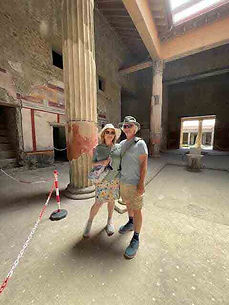
Sorrento
May 28 - 29
High: 70
Low: 68
Partly to mostly sunny
Along the way
Pompeii, Part One
We next headed out for two nights in Sorrento. On the way there we stopped for a tour of Pompeii. It was, as expected, crowded, but Gaetano is an experienced guide who knew the best ways to tour while also keeping to the shade as much as possible, which is no small consideration! Pompeii is one of those places where a knowledgeable guide is important. He knew how to make sure we got the most out of the visit despite the crowds.



As extensive as the parts of the city that have been unearthed are, much of it remains buried. The irony of digging out these ruins that are so well preserved is that each one we uncover immediately starts to decay in the elements. Archeologists have to maintain a careful balance between preservation, research priorities, and the practicalities of archaeological work.
This tour lasted about two hours and covered the "greatest hits" of Pompeii. Lunch was on our own, but we all agreed to be on our own together. Luckily there is a good restaurant that is set up for groups and was able to accommodate us.

The Forum:
The central public space of Pompeii, the Forum was the heart of political, religious, and social life. It is surrounded by important buildings, including temples, basilicas, and shops.

The Garden of the Fugitives:
This sobering area features plaster casts of victims who were caught in the eruption of Mount Vesuvius.
The Baths:
The public baths in Pompeii are well-preserved and showcase the Roman bathing culture. They include various rooms for hot and cold baths, as well as areas for socializing.


The remains of a thermopolium (a fast-food restaurant) nearby also highlighted daily life in the city.

The House of the Faun:
One of the most famous houses in Pompeii, it was a large and luxurious residence. The house is named after a bronze statue of a dancing faun found on the premises.
The House of the Vettii:
Another of the most famous and well-preserved residences in Pompeii. We had to wait in line to go here because it is such a popular tour spot. The Vetti family is believed to have been freedmen of an aristocratic family who went on to become wealthy merchants. The EU spent years and millions on a restoration project on the residence, and it gives a real sense of what life might have been like for the wealthy in Pompeii at the time of the eruption.






Sorrento
Our hotel in Sorrento was a nice boutique hotel on a narrow street behind old fortified walls. It was cheerful and bright, and had rooms with balconies.
 |  |
|---|---|
 |  |
 |  |
 |


That was followed by a gelato-making demonstration. I don't think any of us expected this to be nearly as fun (and yummy!) as it was. Shoutout to Steve for giving me permission to add the video of his participation in the demo to this site.
After some time to get settled in we met for cocktails and an orientation tour of the city. Because we had the next day to ourselves, Bea made sure that we had all the info we might need to get around to do whatever we chose to do. Many people chose to go to Capri, but we had different plans.

If you see a restaurant advertising that they have garlic bread, their clientele probably isn't locals. Garlic bread isn't a thing in Italy.
Pompeii, Redux
We had the next day to ourselves, and because Pompeii had been the driving force of choosing this tour, we had arranged to go back with a private guide. This tour included destinations outside of Pompeii as well.
It turned out that we were incredibly fortunate in our timing. Our guide had gotten an email just that morning letting him know that he would be allowed to take us in to see the most recent excavations in the Regio IX section. These are ruins that are part of the BBC show "Pompeii: The New Dig". It was his first time seeing them and he was every bit as excited as us!

They have scaffolding set up under cover above the ruins, and we were able to walk them and watch the archeologists work below us. And because it wasn't widely known that they'd be letting people in, we were there almost by ourselves. It was an absolute highlight of the trip and, like much in life, it was simple serendipity.
Unfortunately (for the purposes of this scrapbook, and my aging memory) they did not allow us to take pictures while inside. They said it was because they didn't want cameras being dropped from the scaffolding into the ruins, but I personally think it was because people were actively working below us, and who wants to be photographed every moment of their working day?
Because we'd already done the greatest hits the day before, Italo was able to take us where the crowds don't go. It was a little surreal getting to walk around empty buildings on our own.


He also took us to views where we could really get a sense of just how large this city had been.

Situated just outside the city walls of Pompeii, this is one of the most significant archaeological sites in Pompeii, renowned for its well-preserved frescoes.
The frescoes include the initiation of a woman into the cult of Dionysus, scenes of revelry, and depictions of mythological figures. The imagery suggests a focus on themes of fertility, rebirth, and the transformative power of the divine.
Before the eruption, Oplontis was a wealthy resort town. We visited the Villa of Poppaea, which is believed to have been owned by Poppaea Sabina, the second wife of Emperor Nero. The villa is very large, with extensive gardens and elaborate frescoes. What really strikes you as you walk up is how far below the current ground level the buildings are. I was able to really understand how deep the lava was in a way that wasn't clear to me in Pompeii.
Boscoreale was a rural settlement, situated in the fertile area of the Campanian plain. It was primarily an agricultural community, benefiting from the volcanic soil of the region, which was ideal for farming. Today the excavated ruins of one of the farms, Villa Regina, is available to tour. There is a museum at the site that houses many finds from the area.
This was another fortuitous aspect of the day: our guide's mother had worked at this museum, and he pointed out the apartment next to the ruins where they had lived. He had literally grown up there and was excited to get to show it to us.
But wait, there's more!
Returning from this adventure was not the end of our day. Today was the day that we got to participate in one of the excursions that gets the most glowing comments in the reviews of this tour: A family dinner in someone's home. The reviews are spot on. The home has lovely gardens and as you walk through them it sets the stage for a special evening.


We all gathered for dinner at a long table in the family's kitchen. The food (and wine!) was all homemade and absolutely delicious. In traditional Italian style, large bowls of many different items were passed around and we could help ourselves to whatever we'd like.
This was accompanied by lively conversations and much laughter. It was a highlight of the trip.























